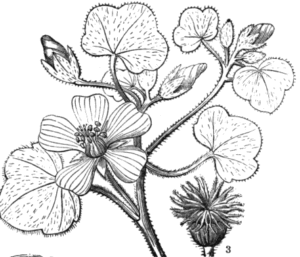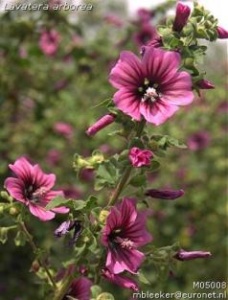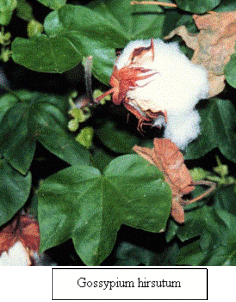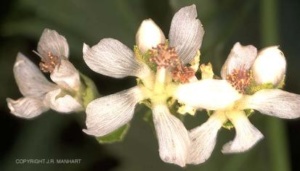VANNIER THIBAULT
INTERNATIONAL CLASS THESSALONIKI
8/04/2000
The Families of Flowering Plants
FAMILLY MALVACEAE.
- I) TAXONOMY
DIVISION: MAGNOLIOPHYTA ( ANGIOSPERMA )
CLASS: MAGNOLIOPSIDA ( DICOTS)
SUBCLASS: DILLENIIDAE
ORDER: MALVALES
FAMILLE: MALVACEAE
II) DESCRIPTION
Habit:
Cosmopolitan family of herbs, shrubs and trees .
Leaf form & Leaf anatomy :
Alternate, stipulate. Spiral leaves; petiolate; non-sheathing; simple.

|
Reproductive type, pollination:
Plants hermaphrodite (usually). Floral nectaries present .

Inflorescence:
Flowers solitary, or aggregated in ‘inflorescences’; in cymes. The terminal inflorescence unit cymose. Inflorescences compound cymose, composed of cincinni.


Floral morphology:
Flowers with 5 free petals, subtended by five sepals and (often) epicalyx. Flowers cyclic.
Perianth with distinct calyx and corolla:
Calyx 5; polysepalous, or gamosepalous (basally).
Corolla 5; polypetalous ; often asymmetrical. Petals convolute in the bud..

Androecium (5–)15–100 (i.e. usually ‘many’). Androecial members branched; adnate (to the petals); coherent (the filaments forming a tube);
Androecium exclusively of fertile stamens .
Stamens (5–)15–50: isomerous with the perianth.
Many stamens fused characteristically into tube around the pistil, and style is characteristically branched . The numerous stamens are monadelphous (united by filaments into a tube).
Gynoecium (1–)5(–100) carpelled (i.e. sometimes ‘many). The pistil 1–5(–100) celled. Gynoecium syncarpous; superior. Ovary (1–)5(–100) locular . Styles (1–)5(–20); Placentation axile. Ovules 1–50 per locule .


FLORA FORMULA:

Fruit:
A 5-celled capsule fruit. Fruit non-fleshy (usually), or fleshy; dehiscent, or indehiscent, or a schizocarp. Fruit a capsule (usually), or a berry (Malvaviscus).

III) Geography:
Frigid zone to tropical. Cosmopolitan tropical and temperate, also Iceland.We can find some familiar plants of deserts and rangelands, the globe mallows (Sphaeralcea spp.)
IV) REPRESENTATIVE GENERA AND SPECIES:
Species 1000. Genera about 100;The main genera are:
Malva:


| Malva neglecta |
Lavatera:


Gossypium
Some 20 species are found in tropical and
subtropical regions. Cultivated forms are
grown in Old and New Worlds to provide
cotton which consists of long hairs covering
the seeds. Cotton seed oil is obtained by
crushing the seeds; the oil cake, following
expression, is used for cattle feed.
Hibiscus
300 species are found in tropical and subtropical regions.

| Hibiscus rosa-sinensis |
Sida
200 species are found in warm regions, especially in America. Some have spines.

| Sida hermaphrodita |
V) USES:
About 15 species have an important economical interest.
These species have Economic importance for:
Human food: oil/fat, beverage base, vegetable. Animal food: fodder. Food additives: flavoring. Materials: fiber, lipids, wood. Vertebrate poisons: mammals. Environmental: ornamental. Weed: potential seed contaminant .
For example:
Hibiscus: 300 species are found in tropical and subtropical regions. Hibiscus abelmoschus (musk-mallow) is used as an insecticide and in herbal medicine as a topical remedy for itching (Wren 1968). This species provides Ambrette seed of perfumery (Arctander1960). Hibiscus rosa-sinensis is used to blacken the eyebrows and shoes and the young leaves are eaten as spinach (Irvine 1961). Hibiscus sabdariffa is used for making jelly (Behl et al. 1966). Hjorth (1965) observed allergic contact dermatitis from species of the genus with significant positive patch test reactions. Acase of periocular eczema was traced to Hibiscus (Kaalund-J?rgensen 1951). ‘ochra’ (‘okra’) is the young fruits ofHibiscus esculentus
The genus Gossypium is the most economically important in the Malvaceae family, being the plant from which we derive the textile known as cotton. The clothing we wear actually comes from the tufted hairs that cover the plant’s seeds. The mostcommonly grown species in the United States is G. hirsutum, though there are other species and polyploid varieties fromwhich cotton cloth is made.



| Coton plant | Coton flower | Cotton bull |
Distribution: Cultivation in warm arid climates. The most important countries for production are China, USA, USSR, India, Pakistan, Turkey and Egypt. Requires deep soil, relatively salt resistant.
Use: Seed fibres (lint) for clothing – Seed oil for cooking oil, technical uses – pressing residues as animal feed Seeds.
Geographical distribution:

Region of origin: red Region of cultivation: green
Cultivation and Breeding:
The origins of cotton are thought to lie in the African – Asian area and on the West coast of America. The original short fibred type has, over the course of approximately 4000 years of domestication, been selected to produce the domesticated strain, the fibre quality and length of which greatly surpasses that of the original form. The two most commercially important tetraploid strains, G. hirsutum (Upland cotton) and G. vitifolium (Sea Island cotton), which have 2 – 4 cm long seed fibres, have been developed in mid and South America from the diploid African – Asiatic and American wild types.
Breeding aims:
Increasing fibre production, early ripening, mechanical harvesting and improvements in resistance to diseases and pests are the most important breeding aims. Length, fineness and elasticity of the fibres play an important role with respect to quality. Additionally, increasing the oil content and reducing the content of gossypol (a poisonous polyphenol found in the seeds) are of interest.
- VI) LITTERATURE USED
Watson, L., and Dallwitz, M. J. (1992 onwards). ‘The Families of Flowering Plants: Descriptions, Illustrations, Identification, and Information Retrieval.’ Version: 19th August 1999. http://biodiversity.uno.edu/delta/. Dallwitz (1980), Dallwitz, Paine and Zurcher (1993 onwards, 1995 onwards, 1998), and Watson and Dallwitz (1991) should also be cited).
Botanical dermatology database:
http://bodd.cf.ac.uk/botdermfolder/botdermp/prim.html
The vascular plant image gallery:
Http://www.csdl.tamu.edu/flora/imaxxprm.htm
Image from wisconsy botany
Image from reed college
Http://web.reed.edu/academic/departmens/biology/courses/
Plant with economic interest.
Http://www.ars-grin.gov/npgs/tax/taxecon.html
VANNIER THIBAULT
The Families of Flowering Plants
PRIMULACEAE FAMILY
I) TAXONOMY
DIVISION: MAGNOLIOPHYTA
CLASS: MAGNOLIOPSIDA
SUB CLASS: DILLENIIDAE
ORDER: PRIMULALES
FAMILY: PRIMULACEAE

II) DESCRIPTION
Habit:
Herbs. Perennial (commonly); with a basal aggregation of leaves (often); often rhizomatous, or tuberous.
Leaf form and Leaf anatomy.
Leaves alternate, or opposite, or whorled. Leaves exstipulate..
Reproductive type, pollination.
Plants hermaphrodite.

Inflorescence:
Flowers solitary, or aggregated in ‘inflorescences’; in heads, in umbels, and in panicles.
Flowers:
Flowers ebracteolate ;cyclic.
Perianth with distinct calyx and corolla
Calyx (3–)5(–9); gamosepalous; regular; persistent (usually); imbricate
Corolla (3–)5(–9); gamopetalous; imbricate.
Petals deeply bifid to bilobed.
Androecium (3–)5(–9), or 10. Androecial members adnate (to the corolla);
Stamens (3–)5(–9); inserted near the base of the corolla tube, or midway down the corolla tube, or in the throat of the corolla tube; isomerous with the perianth; alternisepalous; opposite the corolla members.
Gynoecium supposedly 5 carpelled. Carpels usually isomerous with the perianth. Gynoecium syncarpous; eu-syncarpous; superior (usually). Ovary 1 locular (and no evidence of partitions). Gynoecium stylate. Styles 1 .Stigmas 1 (simple); Placentation free central. Ovules in the single cavity (5–)7–100 (usually ‘many’).


Fruit:
Non-fleshy; dehiscent (usually); a capsule (usually).
Fruit (1–)2–100 seeded (i.e. to ‘many’).
III) Geography.
Frigid zone to tropical. Widespread, but centred in the North temperate.
IV) Representative genera and species
Species 1000. Genera 20; Anagallis, Androsace, Ardisiandra, Bryocarpum, Cortusa, Cyclamen, Dionysia, Dodecatheon, Glaux, Hottonia, Kaufmannia, Lysimachia, Omphalogramma, Pelletiera, Pomatosace, Primula, Samolus, Soldanella, Stimpsonia, Trientalis.
The main genera are:
Anagallis:28 species are found in western Europe, Africa and Madagascar. One species is pantropical and two species are found in South America.

Cyclamen
15 species are found in Europe and from the Mediterranean region to Persia.

| Cyclamen persicus |
Lysimachia
200 species are cosmopolitan, especially found in eastern Asia and North America.

Primula
500 species are found in the northern hemisphere especially in hilly districts. A few species are found elsewhere e.g. at the Strait of Magellan.

Soldanella

V) USES
According to the world economic plant data base, About twenty species from the family primulaceae have economical interests; Most of them have environmental, ornemental interest.
Three species of cyclamen are rare or endangered: Cyclamen cilicium; Cyclamen coum; Cyclamen hederifolium.
Some species are poisoning:
Anagallis arvensis
Scarlet pimpernel (Anagallis arvensis) is a naturalized plant found across parts of southern Canada. The plant contains several toxins that have poisoned livestock, and an irritant in the plant hairs can cause allergies in humans.
Cyclamen (Cyclamen persicum) is a houseplant that has a toxic saponin, cyclamin, in the tuberous rhizomes. The rhizome is bitter and found underground, so that children or family pets are unlikely to be exposed to the toxins.
Primula (Primula obconica) is an ornamental herb that may be grown indoors or outdoors. Sensitized humans develop dermatitis from exposure to the allergen contained in hairs on leaves and other plant parts. Pollen also can cause dermatitis.
- VI) LITTERATURE USED:
Watson, L., and Dallwitz, M. J. (1992 onwards). ‘The Families of Flowering Plants: Descriptions, Illustrations, Identification, and Information Retrieval.’ Version: 19th August 1999. http://biodiversity.uno.edu/delta/. Dallwitz (1980), Dallwitz, Paine and Zurcher (1993 onwards, 1995 onwards, 1998), and Watson and Dallwitz (1991).
Botanical dermatology database:
http://bodd.cf.ac.uk/botdermfolder/botdermp/prim.html
The vascular plant image gallery:
Http://www.csdl.tamu.edu/flora/imaxxprm.htm
Canadian poisonous plant information system data from agricuture Canada.
Http://res.agr.ca/brd/poisonpl/title.html
Image from wisconsy botany
Image from reed college
Http://web.reed.edu/academic/departmens/biology/courses/
Http://www.ars-grin.gov/npgs/tax/taxecon.html